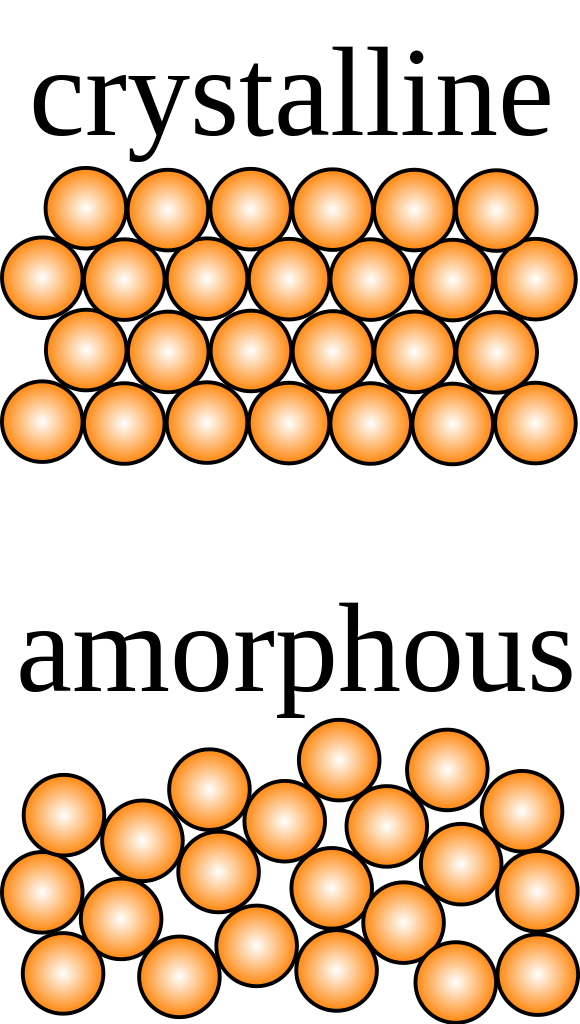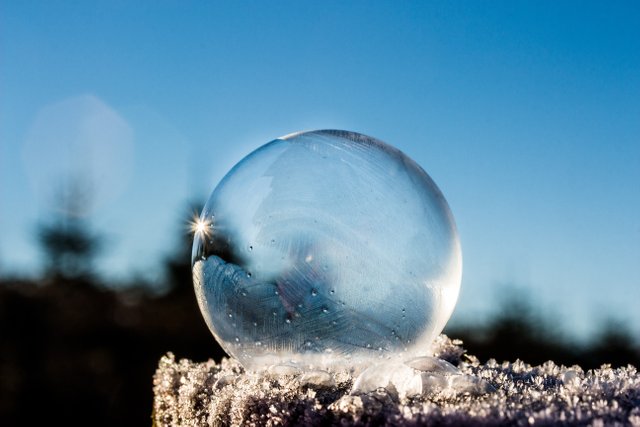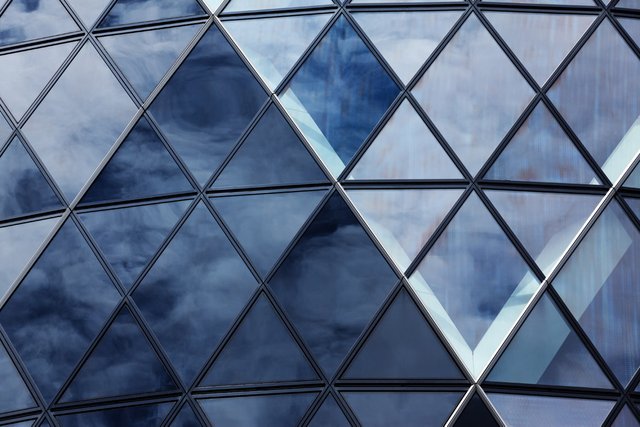Why Can We See Through Glass?
Have you ever gazed out of your window and wondered how the glass that makes it is so invisible yet so solid, at the same time? That’s the sort of question you ask yourself 20 minutes into your shower. This article will not only help you understand why glass is transparent, but why other things can be transparent.
What is Glass?
Glass is made simply by melting sand and cooling it into the shape you want [1]. It really is that easy; in fact, if you have an oven that reaches temperatures of 1700 degrees Celsius, try it yourself!
Is glass a solid or a liquid?
This question may puzzle some of you but it’s actually a great one to ask. Glass is a bit of both; in fact it is known as amorphous solid - which is neither a solid or a liquid. When normal liquids are cooled, their particles eventually arrange themselves into a regular structure; thus becoming a solid. What about amorphous solids?
Why are amorphous solids different?
Imagine you can see the particles moving around in a liquid; if you were to take a snapshot at any time - you have the structure of an amorphous solid. In other words, when liquid sand is cooled, its particles just freeze as they are – they do not rearrange themselves into a regular crystalline structure [2].

Figure 1: Image showing the structure of a crystalline (normal) solid and an amorphous (glass) solid
So why is glass transparent?
Now that we know a bit about glass, we can talk about its transparency. To answer this question we need to look at what happens on an atomic scale when light interacts with electrons. As you may know; an atom is made of electrons which orbit a nucleus. What you may not know, is that an atom is mostly empty space. If an atom was a football stadium, a ping pong ball in the middle would be the nucleus and little fruit flies flying around this ping pong ball would be the electrons
How does light interact with the atom?
Firstly we must be aware that light has a property called a wavelength. All you need to know is that different wavelengths means the light has different energies. For example, ultraviolet light has more energy than red light (which is why UV can damage our DNA).
Electron interaction
When light of a certain wavelength comes into contact with an atoms electrons 3 things can happen [3]:
- Excitation - if… and only if the energy of the light is equal to the electron energy, this electron will move up to another energy level and then move back down. When it moves down it releases light of different wavelength which can be the wavelength for a certain colour of light hence why things have colour.
- Reflection - If the energy of light is NOT equal to the electron’s, the energy of this light is absorbed by them - then these electrons vibrate, and release light of the exact same energy. Confusing I know, but this explains why you can see your reflection in most things, including glass!
- Nothing happens - since atoms have so much space, the photon passes through unaffected since it has not interacted.
With glass, numbers 2 and 3 apply. A lot of the light passes through, and the energy of light does not match the electrons energy in the atoms of the glass - meaning the photons are reflected. This is why you can see your reflection in glass at times.
But wait…
You may also have a new question to ask. If the atom is that empty, why aren’t all solids transparent? Great question.
Despite the atom having so much empty space, it’s incredibly small. In fact so small that there are about 5 million atoms in just the head of a pin. When these atoms build up in a regular structure, they begin to overlap. All this overlapping eventually creates a solid which light cannot pass through.
Try switching your mobile torch on and press it against the back of your thumb, you will realise you can see the light going through your finger past your fingernails. This is because you have increased the intensity of light so it has more of a chance to pass through the gaps between the atoms!
This is also why some materials such as plastic can be partially transparent; the packing density of atoms is not large enough to block out all light.
If you have any questions, leave them below and until next time, take care.
~ Mystifact
References:
[1] - http://www.explainthatstuff.com/glass.html
[2] - https://www.britannica.com/science/amorphous-solid
[3] - http://science.howstuffworks.com/question4041.htm
Please note; no copyright infringement is intended. All images used have been labelled for re-use on Google Images. If any artist or designer has any issues with any of the content used in this article, please don’t hesitate to contact me to correct the issue.
Relevant articles:
What Makes a Rainbow?
Why does the road look like it's WET on a hot day? The Physics behind a Mirage
The More You Know #3 - The Human Race in a Sugar Cube?
Previous articles:
How do we hear Sound?
Can a coin falling from the Empire State Building kill you?
Will Teleportation Ever Be Possible?
Follow me on: Facebook, Twitter and Instagram, and be sure to subscribe to my website!


I like the idea of answering the hidden questions inherent in the world surrounding us. We've accomplished a ridiculously varied number of technical magic tricks that hide in plain sight. It's good to break that stuff down and appreciate it. Consider doing another post on the process of glass making
I completely agree with you. Questions like this may seem strikingly obvious, but the more you try and actually answer it the more there is to the answer and the more you struggle! Thank you for your comment :)
Lol that's been my issue from the start - literally everything in ten posts was originally going to be in one post - and then everytime i started there would be three things that needed explanation in order to understand what was going on.
That is the beauty of Science! It's never ending yet what we know about everything... is nothing.
WOW! What a nice content you have. Thank you for the information. I learn something through this. Keep on steeming
My pleasure! Keep in touch :)
Great post! Really enjoyed it. Although I already knew most of this, it was awesome that you re-sparked my enthusiasm for such things!
Thank you for your kind comment! I'm glad :)
I would like to add that playing with angles may also help being reflected or going through crystals ;)
Agreed. Depends on the photons hitting the eye. Thanks for your comment :)
This gem of a post was discovered by the OCD Team!
Reply to this comment if you accept, and are willing to let us promote your gem of a post! By accepting this, you have a chance to receive extra rewards and one of your photos in this article will be used on our compilation post!
You can follow @ocd – learn more about the project and see other Gems! We strive for transparency.
I'm mostly curating in #science and am always glad to see quality posts like yours peeking out between the garbage and plagiarism!
I feel like I'm responding to a marriage proposal! Yes, I accept. Thank you for the opportunity!
Awesome! I will nominate you on Thursday, nomination for today and tomorrow is already chosen.
Much appreciated!
Congratulations @mystifact! You have completed some achievement on Steemit and have been rewarded with new badge(s) :
Click on any badge to view your own Board of Honor on SteemitBoard.
For more information about SteemitBoard, click here
If you no longer want to receive notifications, reply to this comment with the word
STOPIf you haven't read it, I would check out Steven Johnson's How We Got to Now: 6 Innovations (one being glass) That Made the Modern World. Fascinating dive!
It's crazy. Without it, we simply cannot enjoy natural sunlight if we stayed inside - I'm not surprised it's one of the 6! Thanks for your comment regardless and I shall add that book to my list!
must read post !!
Thank you for your kind comment, Sir :)
Nice!
I did not understand why glass is transparent. I did not get the explanation with the phone torch and the thumb.
Maybe the atoms are alined, and thus the superposition does not fill the void space of the different atoms, and light can pass?
Thank you. Keep´em coming.
If you put your phone torch on and cover it with your thumb, you can see that some of the light gets through! It was an analogy so that you understand it better! Keep asking questions if you have any left :)
Thanks! That, I get. But how is that related to glass being transparent?
In simple terms, since an amorphous solid is like freezing the arrangement of molecules in water (which is also transparent). There are a lot of gaps. Now considering most of the atom is empty space, light passes straight through.
Since the energy of light is not the same as the electrons energy; if this light hits an electron, it reflects which is why windows can act as a partial mirror dependent on the angle!
Hope this helps
Yes, it did help. Now I get it. Thank you very much. I´ll keep reading. I am very much into physics. And maths. And programming. Uff, so much to learn, such a short life.
Agreed!
Come for the pretty bubble picture. Leave with some book learning. Good stuff.
That is how it should be every time! Thank you for reading the article :)